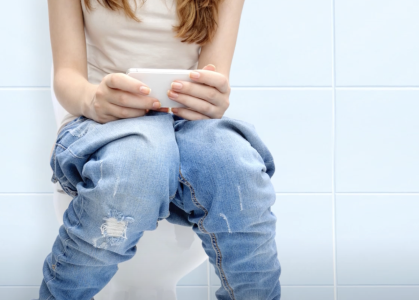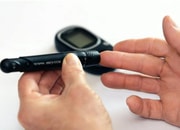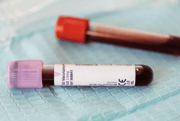Are you putting your health at risk every time you use your phone on the toilet? The disturbing reason you need to stop now
By
Veronica E.
- Replies 0
Let’s face it—we’ve all done it.
You sit down in the bathroom, reach for your phone, and before you know it, you’re scrolling through the news, texting family, or checking the weather.
It feels like a harmless habit, maybe even a moment of peace in a busy day.
But here’s the thing: using your phone on the toilet could be exposing you—and your loved ones—to serious germs.
And some of those bacteria can stick around far longer than you think.
At The GrayVine, we’re here to help you stay informed, safe, and maybe a little more aware of where your phone has been.
Let’s dive into what the science says and how to make a few easy changes that can protect your health.

Bathrooms may look clean, but they’re often the most germ-filled rooms in the house.
When you flush the toilet, it releases what scientists call a “toilet plume”—a fine mist of bacteria and particles that can rise up to five feet in under ten seconds.
That invisible cloud can land on anything nearby: your sink, your towel, your toothbrush—and yes, your phone.
Closing the lid does help—but it’s not foolproof.
According to researchers at the University of Colorado Boulder, particles can still escape and settle on surfaces around the room.
If your phone is nearby—or worse, in your hand—it becomes a landing pad for germs.
Dr. Primrose Freestone, a clinical microbiologist at the University of Leicester, has warned that our phones can harbor all kinds of dangerous bacteria.
That includes E. coli, which can cause diarrhea and stomach cramps, and Pseudomonas, which is linked to blood and lung infections.
These microbes can live on surfaces for hours or even days.
So even if you wash your hands after using the bathroom, you may just reintroduce those germs when you touch your contaminated phone again.
It creates a cycle: phone to hand, hand to mouth, and back again.
Think about everywhere your phone goes.
It travels from your purse to your kitchen counter, to your pillow, and—if you’re like many people—to the bathroom.
Yet, while we clean our sinks or doorknobs every so often, our phones rarely get wiped down.
Studies show that the average smartphone can carry more bacteria than a toilet seat.
That’s right—more than the very place it sits next to in the bathroom.
Some bathroom habits are more germ-spreading than others.
Here’s what to avoid:
The good news? You don’t need to panic—you just need a new routine. Here’s how:
Phones aren’t the only household items that collect bacteria.
Remote controls, keyboards, door handles, and even armrests can carry germs.
Take a few minutes each week to wipe these down, especially during cold and flu season.
Beyond hygiene, stepping away from your phone—even just during a bathroom break—can be a small act of self-care.
It gives your eyes, your mind, and your attention span a breather.
A few minutes of quiet can go a long way.
Read next: Are alarm clocks and photo frames secretly spying on you? The hidden ways your everyday items could be recording you (and why it’s totally legal)

Have you ever thought about where your phone’s been? Do you clean it regularly, or do you have your own tips for keeping screens and hands germ-free? We’d love to hear your thoughts, routines, or even funny stories in the comments!
You sit down in the bathroom, reach for your phone, and before you know it, you’re scrolling through the news, texting family, or checking the weather.
It feels like a harmless habit, maybe even a moment of peace in a busy day.
But here’s the thing: using your phone on the toilet could be exposing you—and your loved ones—to serious germs.
And some of those bacteria can stick around far longer than you think.
At The GrayVine, we’re here to help you stay informed, safe, and maybe a little more aware of where your phone has been.
Let’s dive into what the science says and how to make a few easy changes that can protect your health.

Using your phone in everyday spaces can lead to more bacteria exposure than you might expect. Image Source: YouTube / Bestie Health.
What’s really happening in your bathroom
Bathrooms may look clean, but they’re often the most germ-filled rooms in the house.
When you flush the toilet, it releases what scientists call a “toilet plume”—a fine mist of bacteria and particles that can rise up to five feet in under ten seconds.
That invisible cloud can land on anything nearby: your sink, your towel, your toothbrush—and yes, your phone.
Closing the lid does help—but it’s not foolproof.
According to researchers at the University of Colorado Boulder, particles can still escape and settle on surfaces around the room.
If your phone is nearby—or worse, in your hand—it becomes a landing pad for germs.
Also read: “As Americans in the UK, these everyday moments make us say, ‘Wait… what?’”
The hidden bacteria on your screen
Dr. Primrose Freestone, a clinical microbiologist at the University of Leicester, has warned that our phones can harbor all kinds of dangerous bacteria.
That includes E. coli, which can cause diarrhea and stomach cramps, and Pseudomonas, which is linked to blood and lung infections.
These microbes can live on surfaces for hours or even days.
So even if you wash your hands after using the bathroom, you may just reintroduce those germs when you touch your contaminated phone again.
It creates a cycle: phone to hand, hand to mouth, and back again.
Also read: Shocking germ hotspots in your home—You won’t believe where!
Why phones are especially vulnerable
Think about everywhere your phone goes.
It travels from your purse to your kitchen counter, to your pillow, and—if you’re like many people—to the bathroom.
Yet, while we clean our sinks or doorknobs every so often, our phones rarely get wiped down.
Studies show that the average smartphone can carry more bacteria than a toilet seat.
That’s right—more than the very place it sits next to in the bathroom.
Also read: The risk of a common phone habit in the shower: A woman’s cautionary tale
The biggest mistakes people make
Some bathroom habits are more germ-spreading than others.
Here’s what to avoid:
- Setting your phone on the bathroom floor – That’s one of the most contaminated spots in the room.
- Placing your phone on the tank, sink, or windowsill – These are all within the “splash zone” of the toilet plume.
- Using your phone before washing your hands – This transfers bacteria straight from your hands to your screen, undoing any handwashing efforts afterward.
Also read: Discover the 7 surprising reasons you should save every silica gel packet!
Simple ways to break the habit and stay safer
The good news? You don’t need to panic—you just need a new routine. Here’s how:
- Leave your phone outside the bathroom. Get in the habit of leaving it behind or keeping it in a pocket until after you’ve washed your hands.
- Sanitize your phone regularly. Use a 70% alcohol wipe or a soft cloth with mild soap and water. Don’t use harsh chemicals or soak your phone unless it’s waterproof.
- Treat your phone like a high-touch surface. Just like your faucet handles or remote control, it needs a regular cleaning.
- Clean your bathroom often. Pay special attention to the toilet, floor, and sink area where particles can settle.
- Talk to your family. Make this a household habit—especially for grandkids and teens who are rarely without their devices.
It's not just the bathroom
Phones aren’t the only household items that collect bacteria.
Remote controls, keyboards, door handles, and even armrests can carry germs.
Take a few minutes each week to wipe these down, especially during cold and flu season.
Beyond hygiene, stepping away from your phone—even just during a bathroom break—can be a small act of self-care.
It gives your eyes, your mind, and your attention span a breather.
A few minutes of quiet can go a long way.
Read next: Are alarm clocks and photo frames secretly spying on you? The hidden ways your everyday items could be recording you (and why it’s totally legal)
Key Takeaways
- Using your phone on the toilet can expose it to dangerous bacteria like E. coli and Pseudomonas, which can cause diarrhea, stomach cramps, and serious infections.
- “Toilet plume”—tiny droplets containing fecal bacteria—can contaminate anything within five feet of the toilet when you flush, even if the lid is closed.
- Phones should be kept out of the bathroom altogether and disinfected regularly with alcohol wipes to reduce the risk of bacterial contamination.
- High-touch items like phones, taps, and door handles should be sanitized often, and you should always wash your hands before and after touching them.
Have you ever thought about where your phone’s been? Do you clean it regularly, or do you have your own tips for keeping screens and hands germ-free? We’d love to hear your thoughts, routines, or even funny stories in the comments!






